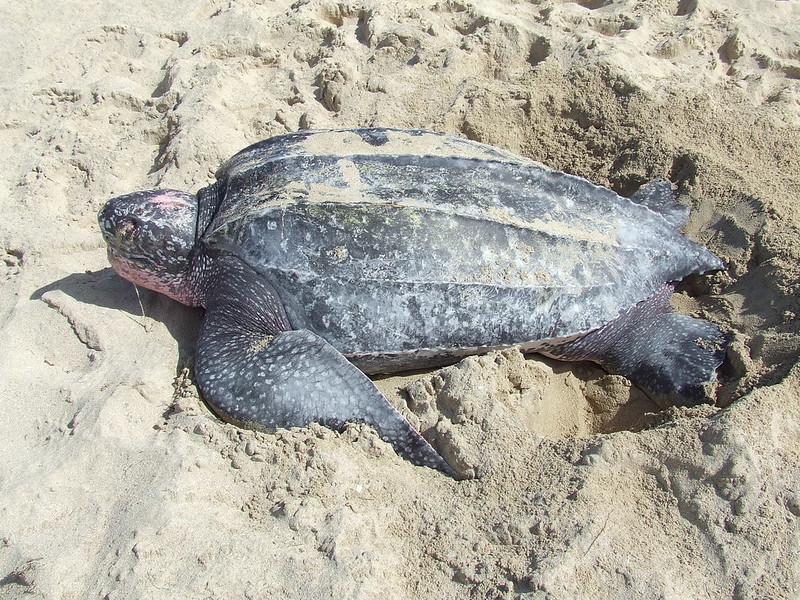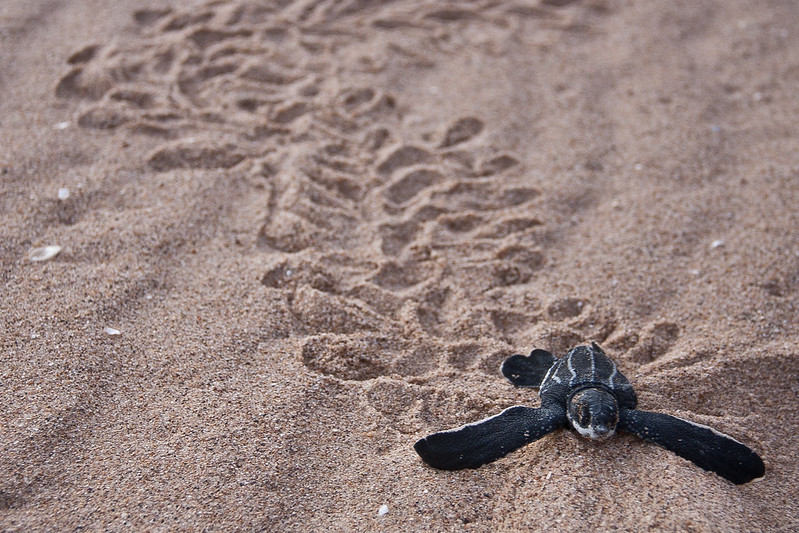The leatherback sea turtle (Dermochelys coriacea), or simply “leatherback,” is the largest turtle and widest-ranging reptile in the world. It began evolving over 100 million years ago and is the last remaining member of the Dermochelyidae family. It has seven subpopulations worldwide, two of which can be found in Canadian waters.
Physical Description

The leatherback gets its name from its leathery shell. Unlike most sea turtles, its shell is slightly flexible and made of fibrous, fatty connective tissue embedded with tiny bones called osteoderms. Leatherbacks are blue-black with white blotches. They have a pink-white underside and a distinctive pink spot on top of their head. An adult’s length, measured along the curve of the shell, is typically about 140–160 cm, and its weight between 250 and 600 kg. Males can be distinguished from females by their longer tails.
Leatherbacks have four large, clawless flippers. They can tolerate cold water thanks to a set of adaptations called gigantothermy, which includes a low metabolism and blood flow adjustments. They also excrete excess seawater salt through large lachrymal glands which produce very salty tears. To facilitate feeding in the ocean, the inside of a leatherback’s mouth and esophagus is lined with spines pointing toward their stomach. These retain their food whenever they expel excess water.
Geographic Distribution and Habitat

Leatherback sea turtles are found in the northwest and south Atlantic Ocean, northeast and southwest Indian Ocean, and Pacific Ocean. Most knowledge of the species’ range is focused on observations at nesting beaches. The largest nesting areas are in the Caribbean and on the African west coast. Other major nesting areas include beaches along the Eastern and Western Pacific coast. No nesting occurs on Canadian coasts.
Leatherbacks only go onto land to nest. Between nesting seasons, they travel to summer foraging grounds. Between June and October, thousands of individuals can be found in the waters of Canada’s Atlantic provinces. Some visit the coastal waters of British Columbia as well, but in much smaller numbers.
Life Cycle
Estimates of leatherback longevity and age of maturity vary widely because they are difficult to observe at sea. Longevity may be around 40–45 years, while sexual maturity may be reached at about 20–30 years of age.
When females are mature, they usually only mate once every 2–3 years. Since a female is capable of storing sperm, she only mates once per reproductive season. She then seeks a suitable nesting beach. She lays eggs about 3–10 times per season, waiting 8–12 days at sea in between. Each time, she digs a nest in the sand, lays 60–100 eggs, then covers them up. During incubation, hatchling sex is determined by the egg’s temperature during the middle trimester. This is called temperature-dependent sex determination. Below about 29°C, hatchlings become male; above 30°C, they become female. Only when temperatures are within that narrow range do both sexes occur.
The eggs hatch about two months later. When the hatchlings emerge, usually at night, they head towards the ocean. They then swim away from land for about 24 hours straight, fueled by the energy from their yolk sac, which they consume after hatching. They are only 6 cm long and will have to grow to about 100 cm before they can complete the long migrations typical of adult leatherbacks.
Diet and Behaviour
Leatherbacks are highly migratory, sometimes travelling up to 20,000 km — the equivalent of about half the world’s circumference — between foraging and nesting grounds. They use light to guide their journey and can also sense the Earth’s geomagnetic field. Leatherbacks feed almost exclusively on jellyfish and can eat up to their own weight in food per day. They frequently dive down 1 km and have been recorded diving deeper than 1.2 km. However, it is unclear whether they dive to find prey, to escape predators or for other reasons. When not diving, they are sometimes spotted resting on the seafloor or basking at the surface.
Relationship to Humans
Historically, humans have consumed leatherback meat and eggs. The turtle’s oil was also used as a varnish, lamp oil, medicine, aphrodisiac and sealant for the hulls of small boats. The Manhousat First Nation of Sidney Inlet, Vancouver Island, reportedly consumed leatherback meat (the Manhousat are now part of Ahousaht First Nation). However, the histories of most other Indigenous peoples only refer to turtles or sea turtles generally, and do not mention the leatherback specifically. Leatherback product trade is illegal today, but domestic consumption of meat and eggs continues to be a significant means of sustenance in some parts of the world, including West Africa and Malaysia.

Threats
Leatherbacks are most vulnerable to predators as hatchlings travelling from nest to sea. Predators, including humans, also harvest eggs from nests. Many researchers view entanglement in fishing gear as the most significant threat because it kills thousands of leatherbacks a year. Light pollution from nearby urbanization tends to disorient hatchlings, who rely on visual cues to find the ocean. Development along beaches also restricts suitable nest areas and creates obstacles to female and hatchling movement. Many types of pollution threaten leatherbacks, too, including oil spills and plastic bags, which they often mistake for jellyfish and eat. Climate change may influence hatchling sex ratios. Since only eggs kept below about 29°C become male, warmer beaches may lead to fewer male leatherbacks. Climate change also involves rising sea levels and increases in extreme weather, which have negative impacts on nesting habitats. However, the species may be able to adapt to climate change relatively well. It has a broad range and females can easily change from one nesting beach to another. They also tend to place some nests in cooler parts of beaches.
Conservation
The International Union for Conservation of Nature lists the leatherback sea turtle as vulnerable. While the species is not endangered as a whole, several populations are critically endangered. For example, the Pacific population decreased by over 90 per cent in 30–35 years, according to a 2012 report from the Committee on the Status of Endangered Wildlife in Canada (COSEWIC). Both COSEWIC and the Species at Risk Act (SARA) list the leatherback as endangered. While international co-operation to protect the leatherback is difficult due to its broad range and open ocean habitat, some progress has been made. For example, beachfront lighting near some key nesting areas has been reduced and fishing gear safety is continually being improved.

 Share on Facebook
Share on Facebook Share on X
Share on X Share by Email
Share by Email Share on Google Classroom
Share on Google Classroom



